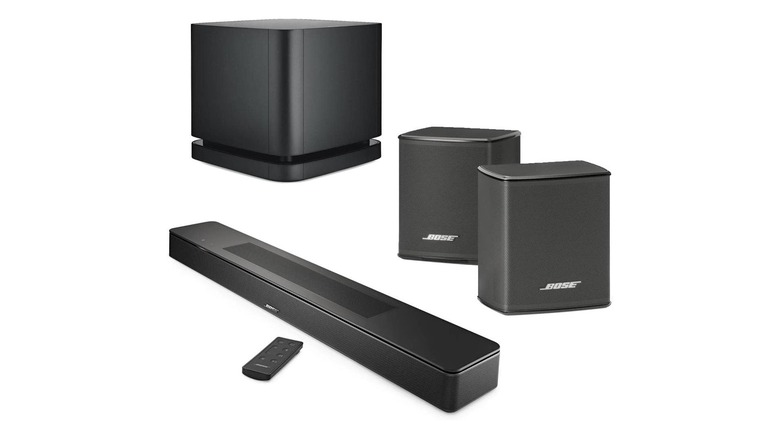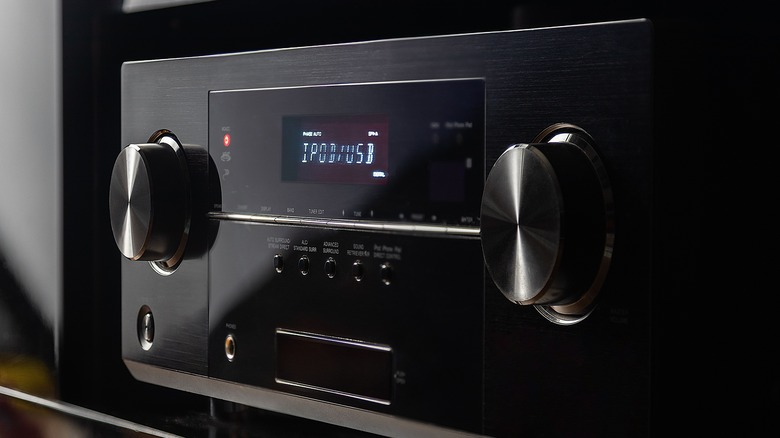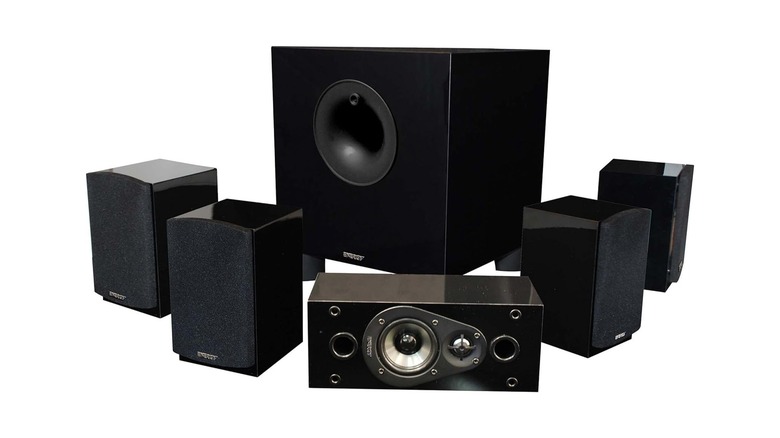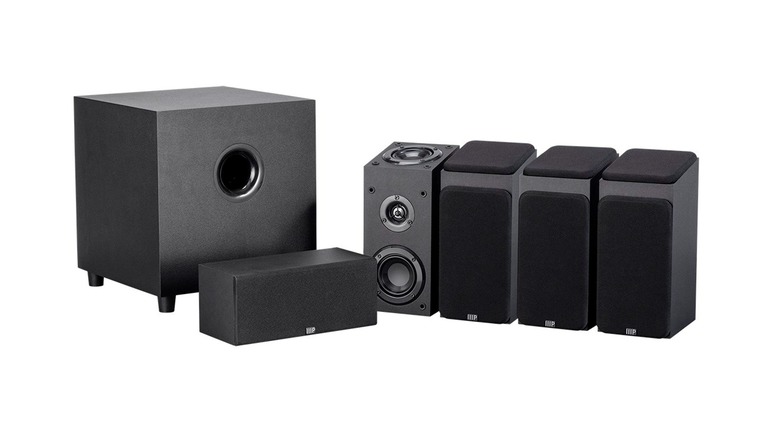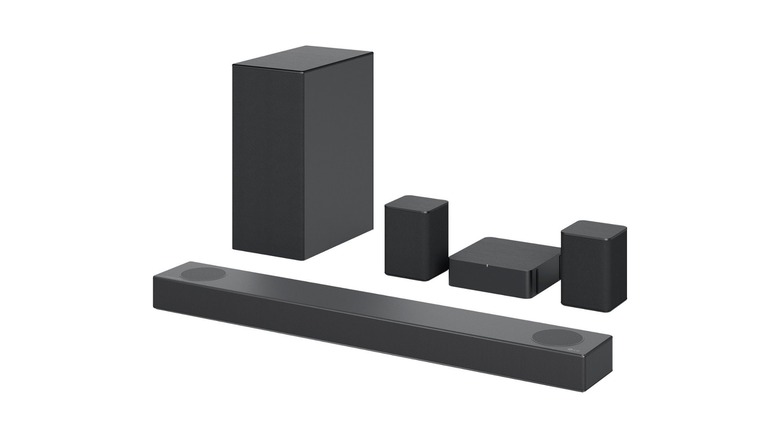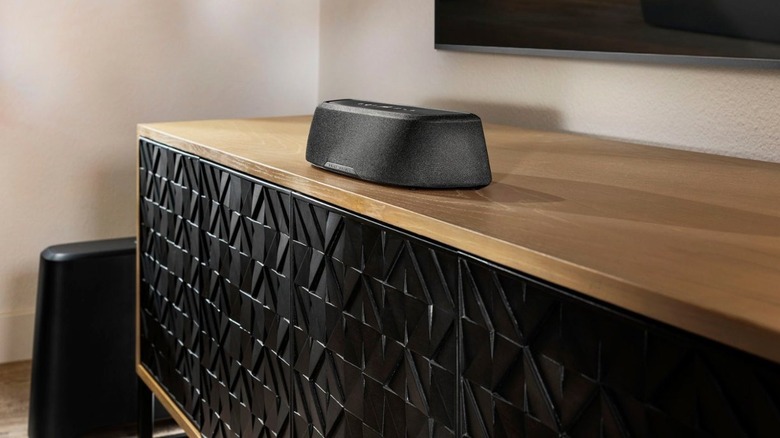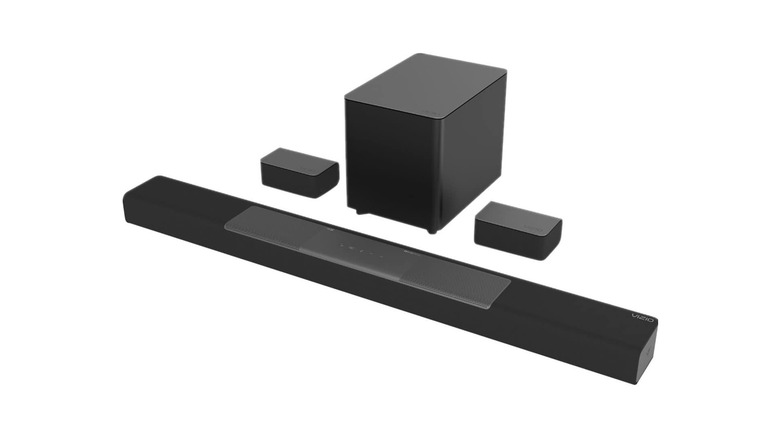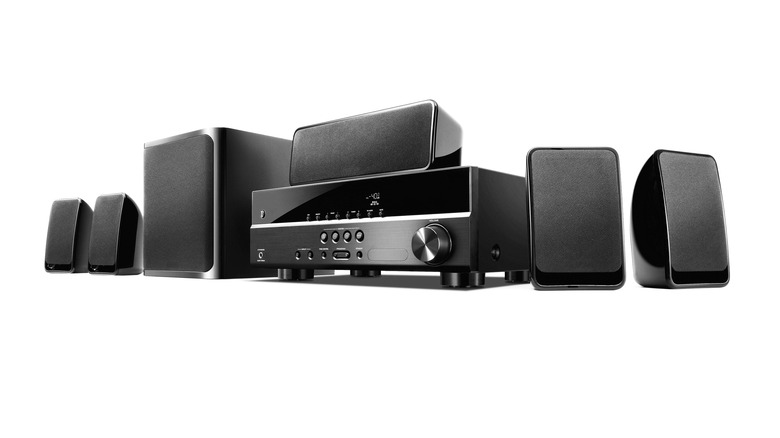5 Affordable Bose Surround Sound Alternatives For Any Budget
We may receive a commission on purchases made from links.
Bose has long been one of the most recognizable names in audio. Though the company dates back to 1964, it's been a household name since 1993's introduction of the Wave Radio, which was advertised incredibly aggressively across all of mass media. These days, the brand is probably best known for its noise-canceling headphones, some of which are sold under the QuietComfort line. Though other companies might deliver better sound quality, Bose is generally considered to have the best noise cancellation in the best overall package. And if you were to go shopping at Best Buy or similar stores, other Bose products will also be displayed prominently, as well, especially soundbars, wireless surround sound systems, and Bluetooth speakers.
There are a couple of problems with Bose, though: One is that, despite their marketing suggesting otherwise, Bose products are not exactly balanced, audiophile-grade gear, resulting in a common refrain among hi-fi enthusiasts being "no highs, no lows, must be Bose." And despite this, Bose gear is pretty expensive, more so than a lot of what would be considered budget audiophile gear. If you want the best possible noise cancellation tech in your headphones, then Bose is the way to go. Otherwise? There are often better buys to be had, particularly when it comes to surround sound systems.
If you want a full Bose surround system, you need to get the wireless Steal The Thunder system for $1,397.00, and that's too rich for most people. So let's take a look at what you can pick up for a lot less, instead.
A note on AV receivers
For simplicity's sake, when writing about the options listed here that consist of passive speakers and a powered subwoofer, we're going to work under the assumption that you can price out an appropriately priced AV receiver to feed them that will fit your budget. There are five major brands of mass-market home theater receivers available at retail — Sony, Yamaha, Pioneer, Onkyo, and Denon — and they're all good. What you pick will just be a matter of price and features, and almost anything from the last decade is going to support the key HDMI features, all the most modern audio formats, etc. Look for sales, deals at specialty retailers, and manufacturer refurbished receivers to get the best deals.
Also, we need to address something that can be confusing: How the number of surround sound channels supported by a given receiver is explained. This used to be more simple, with 5.1 used to denote five channels and a subwoofer, 7.2 used to refer to seven channels and two subwoofers, etc. Height channels in Dolby Atmos speaker layouts add a third number, so a 5.1.4 speaker set, for example, would be the traditional five channels plus a subwoofer and four height channels. Those height channels, though, require their own channel connections from the receiver, so you would need at least a 9.1 receiver to feed everything in such a speaker set. You're not going to find those in this price range. You might be able to find a suitable deal on a 7.1 or 7.2 receiver, though.
Energy Take Classic for discrete wired surround
In the audio world, good products — especially speakers — stand the test of time and are kept in production much longer than other consumer electronics products. One such product is the Take Classic surround speaker set from Energy, a division of Klipsch, which has been on the market for the better part of two decades. The Take Classic has long been considered a set of smaller speakers that outperforms its relatively diminutive physical size while being reasonably priced.
A November 2007 AudioHolics review — basing the speakers' value on the then-MSRP of $599.00, or $878.98 adjusted for inflation — praised the Take Classic's "[a]ggressive, value pricing" and [v]ery musical tonal balance." Reviewer J. Walter Clarke Jr. added that the set "blows away everything else I have heard in its class." Sound & Vision was similarly positive several months later, as was CNET in 2011 when giving it an Editors' Choice recommendation. PC Mag had the same kind of praise in 2012, lauding the surprisingly balanced performance while the speakers sat at what had dropped to a $400.00 price point. All told, it's long been considered a good value, particularly for someone who doesn't have much physical space to work with.
In 2024, the main place to buy the Take Classic appears to be Accessories4Less.com for $349, a longstanding retailer of audio gear that specializes in refurbished items and "new old stock," and which also has a bundle with a factory refurbished Denon receiver for $499.
Monoprice 33832 immersive 5.1.4 surround speakers
Monoprice is a reputable source for high-quality budget audio equipment now, but it was a new frontier in the early 2010s, when the company was known mainly as a great place to get high-quality cables for good prices. The company's shockingly good sub-$100.00 5.1 speaker set released in late 2011 and was followed by a higher-end sub-$250 system, the 9774, a year later. CNET reviewed the 9774 in February 2013. That's when all hell broke loose.
Though reviewers Matthew Moskovciak and Steve Guttenberg called the 9774 "the best home audio value we've ever seen," they were somewhat troubled by how the set was, by all appearances, a rebadged Energy Take Classic, something Klipsch hadn't approved. Klipsch sued Monoprice, who pulled the 9774 set. The two companies settled, and the 9774 was replaced by the redesigned 10565. The same CNET reviewers assessed the 10565 as sounding even better. As of 2024, that's also discontinued, but now replaced by the 5.1.4 channel 33832 set, which is $209.99 and features up-firing Dolby Atmos-compatible drivers on all four satellite speakers.
Currently, no professional reviews of the 33832 have been published. However, KenH, a long-tenured user on AVSForum.com — a respected user of one of the top home theater forums for a quarter-century — posted in November 2020 that it's indeed the spatial successor to the 10565, utilizing the same drivers. So you can trust that they sound great. Curiously, Amazon doesn't carry the full set, but it does have pairs of the satellites for $104.20.
LG S75QR home theater in a box
What used to be a very popular entry-level category still exists, but only on the periphery: That's the "home theater in a box," or HTIB for short. By the DVD boom at the latest, its common usage was to refer to inexpensive systems built around a dedicated amp, sometimes with a DVD player built in. At the low end of the price spectrum, these have largely been replaced by soundbars, but a few still exist, usually from off-brands, and rarely have professional reviews.
One of very few we could find with a professional review — at RTINGS.com — is, thankfully, from a name brand: The LG S75QR semi-wireless 5.1.2 channel surround system, which retails for $449.99 at Best Buy but can often be found on sale for $349.99. By "semi-wireless," we mean that the front, center, and front height channels are part of a soundbar, which connects wirelessly to a subwoofer, and a receiver module for the rear satellite speakers, which are wired to the module. RTINGS gave it a positive review, saying "it does well for the price, and it's a solid option if you want a simpler setup." Among 1,295 Best Buy customers, meanwhile, the system averages 4.4 out of five stars.
Perhaps best of all, it's got a modern feature set with HDMI ARC connectivity and full support for Dolby Atmos and DTS:X immersive audio, as well as Dolby and DTS's other commonly used codecs. It also has a pretty decent app you can use to control the entire system with your phone over Bluetooth — no remote hunting necessary. If you want something simple with (mostly) discrete surround sound, minimal wires, and no need to buy a receiver, then this is a great pickup.
Polk MagniFi Mini AX soundbar with wireless subwoofer
As noted earlier, soundbars, with their "good enough" virtual surround sound effects, have largely taken over the all-in-one home theater market, especially when it comes to the lower end of the price scale. In professional reviews, though, that surround virtualization doesn't always impress the reviewers. One clear exception to that in the $500 and under price range is the MagniFi Mini AX soundbar with wireless subwoofer from longtime quality speaker maker Polk, which is available for pennies below our price limit at both Amazon and Best Buy. This is explicitly a 3.1 channel setup, but the surround effects impressed some notable reviewers.
"[T]hanks to its digital signal processing (DSP) technology, it produced a surround-sound effect that was, in some cases, more natural-sounding (if less dramatic) than soundbars using dedicated surround speakers," wrote Brent Butterworth at The Wirecutter, naming the MagniFi Mini AX the best overall soundbar he reviewed. At What Hi-Fi, Jez Ford remarked that Polk's "Guests will ask, 'where are all the speakers?'" promotional copy was more than just fluff, while Michael Gowan at Tom's Guide said that "when Thor flings Stormbreaker at the Outriders in 'Avengers: End Game,' the Mini AX made it sound like it was moving through the room." At TechHive, Ben Patterson wrote that "the Mini AX pumps out dynamic, immersive audio with a wide soundstage that belies the soundbar's compact form factor."
If you don't have room for more than a soundbar and a wireless subwoofer, this looks like a great pick.
Vizio V-Series and M-Series home theater in a box
For something like the LG pick with more options and price points, there's the Vizio's V-Series and M-Series. Also differentiating them is the lack of a dedicated wireless surround box; the satellites are wired to the wireless subwoofer instead.
The model numbers might vary a little depending on the retailer, but there are a few basic options. Amazon has the V51x-J6, which is listed as retailing for $219.99 but is often on sale for under $200, while Best Buy has the seemingly identical V51-H6 for $249.99 or $199.99 for My Best Buy Plus members.
For the M-Series, Amazon has a 2022 vintage 5.1 version listed as retailing for $329.99 but usually on sale for $300 or less, as well as a 5.1.2 version that's listed as retailing for $499.99 but usually goes for $300 to $420. Meanwhile, Best Buy has the 5.1 version for $299.99 ($284.99 with Plus) and the 5.1.2 version for $499.99 ($415.99 with Plus).
Professional reviews are a lot more plentiful for these than for the LG, and are uniformly positive. Our own SlashGear review gave the 5.1 M-Series model a nine out of 10 score, praising the overall sound quality and alternate layout options for those who don't have the space to use the surrounds in their usual spots, while Tom's Guide singled out just how affordable it is. Newsweek praised the 5.1.2 version as the best immersive option under $500, with Tech Radar being similarly positive. As for the V-Series, Digital Trends, and Reviewed gave it their versions of "editors' choice" endorsements.
Methodology
In putting together this list, the two main factors were a hard price cap of $500 and trying to rely on the consensus view in professional reviews as much as possible, all while trying to present a relatively diverse set of surround sound options. The price cap and relative necessity of professional reviews cut off many options that might have been considered. All the speaker/receiver combos that we could find, like from Onkyo and Yamaha, or retailer bundles of separately packaged speakers with a receiver, started in the $550 to $600 range for new sets with full warranties. (If you can find factory refurbished bundles in stock at sites like Accessories4Less, you can get below $500, but quantities seem limited.)
Receiver bundles aside, basically everything we could find that wasn't listed here that could be classified as a sub-$500 home theater in a box was from an off-brand with no professional reviews available. That doesn't mean they're bad, and some looked intriguing, including fully wireless surround systems with HDMI ARC connectivity. Still, we couldn't recommend them in entirely good faith without professional reviews or our own hands-on assessment.
In looking for professional reviews, we tended to stick with established audio and electronics review sites. The exception was to connect the current Monoprice speakers to the Energy Take Classic knock-offs of the past. But if you're going to use a non-official, non-journalistic source for something like that, then an AVSForum user with a roughly 25-year history and over 46,000 posts on the site is as good as any.
